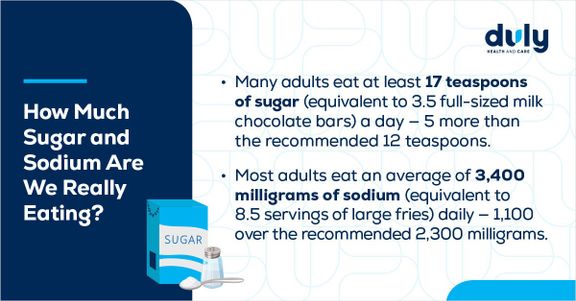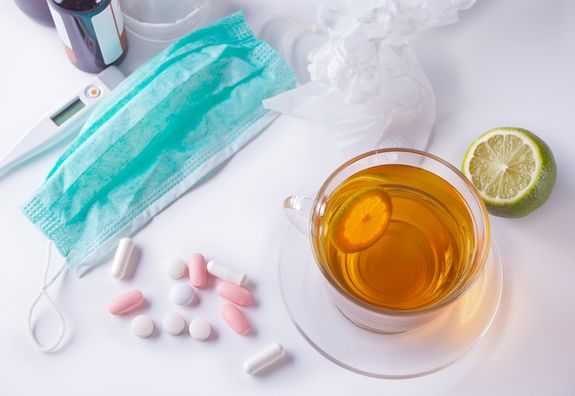Eating a healthy, well-balanced diet can be tough. With all the options available, it can be confusing to determine what’s healthy and what’s not.
On top of that, many products may seem healthy — and even be advertised as healthy alternatives — but contain loads of sugar, sodium, or other unhealthy ingredients. Excess sugar can lead to weight gain, type 2 diabetes, and heart disease, and too much sodium can cause high blood pressure, a major risk factor for stroke and heart disease.

How Much Sugar and Sodium Are We Really Eating?
- Many adults eat at least 17 teaspoons of sugar a day (equivalent to 3.5 full-sized milk chocolate bars) — 5 more than the recommended 12 teaspoons.
- Most adults eat an average of 3,400 milligrams of sodium daily (equivalent to 8.5 servings of large fries) — 1,100 over the recommended 2,300 milligrams.
Eating a healthy diet, including limiting sugar and sodium, is key to preventing chronic health conditions and promoting your overall wellness. You can start by limiting these 6 foods (and beverages) that you thought were healthy — but really aren’t.
1. Sweetened Yogurt
Yogurt is a healthy food and contains some naturally occurring sugar from lactose, but certain varieties also contain a lot of added sugars. Sugar can be added to yogurt to add sweetness. Try to look for yogurts that have zero added sugar when reading the Nutrition Facts label.
The good news is that many companies are coming out with lower-sugar versions of yogurt that can taste great and contain lower calories, sugars and carbohydrates. You can also try plain, unsweetened yogurt and add your own favorite fruits.
2. Dried Fruit
Fruit is an essential part of a healthy diet. But dried fruits can come with some downsides.
Dried fruit makes the fruit smaller (think grapes dried into raisins), so it’s more calorie dense and easier to consume larger amounts and more calories. For example, you could eat 15 grapes or 2 tablespoons of raisins for the same amount of calories and carbohydrates. By eating more food, you’ll consume more calories and carbohydrates.
Dried fruit does have some of the same benefits as fresh fruit, like fiber and antioxidants. If fresh or frozen fruit isn’t an option, simply monitor how much dried fruit you eat and keep portion sizes appropriate by looking at the serving size listed on the Nutrition Facts label.
Contact your primary care physician to see if you could benefit from nutritional services.
3. Packaged Deli Meats
A sandwich with meat, veggies, and whole-grain bread might sound like a healthy lunch, but your deli meat might be more problematic than you think.
Just one slice of ham has over 365 milligrams of sodium. If you put four slices on one sandwich, that number rises to over 1,400 milligrams. This takes up well over half of your daily allotment.
Processed meats also contain nitrates and have been linked to chronic diseases, like diabetes, cancer, and heart disease.
You might opt for a nitrate-free, lower sodium lunch meat in moderation. You can also opt for a half sandwich and pair it with a nutritious salad full of fresh vegetables. Baked and diced chicken breast along with tuna can be good substitutes for deli-meat.
4. Granola Bars
Granola bars are often seen as a healthy go-to for people on the go. In fact, over 70% of Americans consider granola bars to be healthy — but less than one-third of nutritional experts are on the same page.
Many granola bars have fiber, protein, and whole grains — all key parts of a healthy diet. Not all granola bars are created equal. Many also have plenty of added sugar, sometimes up to 25 grams in one bar.
Read the Nutrition Facts label and check out grams of added sugar. If it has 25 grams of sugar, you’re already at the daily recommended intake for women (25 grams) and almost there for men (36 grams). With this in mind, try to find one with less added sugar. Also, try to find granola bars that contain fiber (2 or more grams dietary fiber per bar) and limit carbohydrates to 15 – 20 grams per serving.
5. Low-Fat or Fat-Free Foods
Limiting fat, specifically saturated fat, in your diet can help you stay healthy and prevent heart disease. But low-fat and fat-free foods are not the only — or even the best — way to do that.
The problem with low-fat or fat-free foods is that people tend to overindulge in these products because they have fewer grams of fat. And while this is true, they still have sugar and calories.
For instance, half of a cup of regular whole milk vanilla frozen yogurt has 3 to 4% fat and 104 calories. The same serving size of fat-free vanilla frozen yogurt has less than 1% fat — but still 100 calories.
Also, low-fat or fat-free foods sometimes have more sodium and sugar, which counteracts its other possible benefits.
Try to focus on limiting saturated fat, by choosing lower-fat dairy products and lean meats. For instance, skim milk, lean ground turkey, fish and grilled chicken breast with the skin removed are all lower in saturated fat than beef, cheese and high-fat meats like salami and hot dogs.
6. Diet Soda
Diet soda may sound like a healthy alternative to regular soda, which is full of sugar (roughly 39 grams in one can of soda), but diet soda is not a health food and often takes the place of water. According to some studies, diet soda consumption may also be an independent risk factor for diabetes.
Diet soda may also trigger more sugar cravings. Instead of soda, try jazzing up water with sliced fruit, like lemons or oranges, or herbs, like mint leaves or basil. If you like carbonation, try a sparkling water too.
Eating Healthier Is Simpler Than You Might Think
With all of the products that emphasize healthier options, it can be confusing to stick to a healthy diet. The good news is that eating healthy is probably more straightforward than you think.
A healthy diet focuses on eating more real food including fresh fruits, vegetables, whole grains, protein, and dairy. It also limits added sugars, sodium and processed foods. And remember, healthy eating is a pattern. If you eat healthy more often than not, you’re headed in the right direction.
Health Topics:








